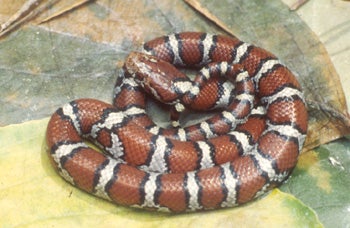SCIENTIFIC NAME:
Lampropeltis triangulum syspila
STATUS:
Uncommon to infrequently encountered in northwestern portion of Appalachian Plateau. A secretive snake usually found in, and under, rotting logs, and occasionally seen on roads at night. Intergrades eastward with eastern milk snake. MODERATE CONSERVATION CONCERN.
DESCRIPTON:
The red milk snake (Lampropeltis triangulum syspila) is a medium sized snake that may reach a length close to 40 inches. The dorsal surface of the snake is characterized by black-bordered red saddles with alternating smaller blotches of the same color located laterally. The intervals between the saddles are white, cream, yellowish, or gray in color. The belly is white with large rectangular markings arranged irregularly or in a checkerboard fashion. The head has various markings of red bordered by black on top. The first saddle marking on the body is not connected to the head pattern. Three subspecies of Lampropeltis triangulum occur in Alabama, L. triangulum elapsoides (scarlet kingsnake), L. triangulum triangulum (eastern milk snake), and L. triangulum syspila (red milk snake).
DISTRIBUTION:
The range of L. triangulum syspila extends from northwest Alabama west and north into Oklahoma, Indiana, Illinois, Iowa, and South Dakota. In Alabama, L. triangulum syspila has been documented within the Bankhead National Forest in Lawrence and Winston counties in the extreme northwestern region of the state. Intergrades between L. triangulum syspila and L. triangulum triangulum have been found in Dekalb and Jackson counties in northeastern Alabama.
HABITAT:
Red milk snakes are usually associated with dry, open woodlands and woodland edges. They seek shelter in rock outcrops and under logs.
FEEDING HABITS:
Food items consist primarily of small rodents, birds, lizards, and snakes.
LIFE HISTORY AND ECOLOGY:
Information on L. triangulum syspila in Alabama is limited. This species is secretive and seldom encountered. It mates in the spring and deposits an average clutch of seven or eight elliptical-shaped eggs in rotting logs. The incubation period is six to nine weeks. Young range from approximately 5 to 11 inches in length.
REFERENCES:
“Milk Snake”, Online Field Guides. eNature.com.
Mount, R.. 1975. The Reptiles & Amphibians of Alabama. Auburn Printing Co., Auburn, AL. 347 pp.
AUTHOR:
Steve Barnett, Wildlife Biologist, Division of Wildlife and Freshwater Fisheries






